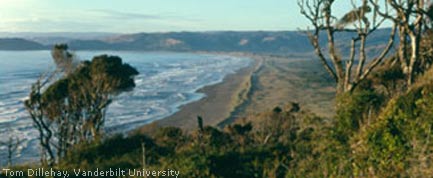Why Did Humans Migrate to the Americas?

The Americas were the last (well, second-to-last if you count Antarctica) continents to be inhabited by early humans. Archaeologists estimate that people entered North America by crossing over the Bering Strait, which back then was a wide swath of land, about 15,000 years ago. In other words, people got here by walking a very long distance. Our image of this major migration is fanciful. When I teach about the peopling of the Americas, I show a slide of people purposefully trekking in a straight line on a tundra from Siberia to Alaska, as if there was some destination on the other side and the only way to get there was to follow the leader, one behind the other. But the truth is that human migration is much more complex, as suggested by genetic evidence presented recently by Ugo Perego and Alessandro Achilli of the Università di Pavia, Italy. Using mitochondrial DNA, they found two rare haplotypes (gene groupings) in modern Native Americans that point to two simultaneous ancestral migrations into this part of the world. One group took the fast track down the Pacific Coast to Tierra del Fuego (they may have used boats for part of the journey) and the other came across the Strait, maybe even with the coastal folks, and then took a sharp left turn past the ice sheet and spread out over inland North America. But what compels people to walk that fast and that far into the unknown? The most obvious reason is that one has to pack up and go because things are not so good at home. Long ago, that probably meant that the climate had changed and made life impossible. It might have become too hot or too cold or too wet, which in turn would have affected not only quality of life but also make survival a shaky proposition. Drought, flood, and temperature changes could certainly push people to move on. Climate change also affects the food supply, and anthropologists have assumed that people came to the Americas because they were following food on the hoof. Humans are famous for wiping out big game as they go, so these early travelers might have been walking behind herds and not realizing they were covering new ground as they ate their way into the New World. People also migrate when they are being chased. Back then, there weren't enough people to cause civil unrest, tribal warfare, or religious persecution, but there could have been conflicts over land use or hunting rights. Or maybe, they came because they could. Humans seem to have a universal penchant for moving around, and not always under duress. These days, people sometimes move to have a new life in a new land, or just for fun. Sometimes they want a new view, an adventure, or they want to reinvent themselves. Maybe the two major groups of people coming to the New World were looking for a new life and they found it beaching it to Tierra del Fuego or chasing the herds across the plains of Canada.
- Gallery: How Weather Changed History
- The World's Biggest Beasts
- Top 10 Intrepid Explorers
Meredith F. Small is an anthropologist at Cornell University. She is also the author of "Our Babies, Ourselves; How Biology and Culture Shape the Way We Parent" (link) and "The Culture of Our Discontent; Beyond the Medical Model of Mental Illness" (link).
Get the world’s most fascinating discoveries delivered straight to your inbox.


